Table of Contents
A microtome is a scientific instrument used to cut very thin slices of material, typically for use in microscopy. The material being sliced can be a variety of things, including biological tissue, plant specimens, or materials for industrial or electronic purposes. The microtome works by holding the material in place and then moving a blade across it in a controlled manner, resulting in a thin slice. These slices can then be mounted on slides and examined under a microscope to study the structure and composition of the material in greater detail. Microtomes are commonly used in fields such as biology, medicine, and materials science.
What is Microtome?
- A microtome is a mechanical device used to slice biological specimens into extremely thin segments for microscopic examination.
- Micro = Small, and Tome = Sliced. Tissue blocks embedded in paraffin wax are most commonly sectioned for microtomy, but the tissue can also be presented in other forms.
- A microtome into which a cutting instrument is clamped is the fundamental microtomy implement. Cummings (1770), a manufacturing company, created wooden manual sectioning instruments that were used exclusively for cutting plants.
- Chevalier (1839) was the first to use the term “microtome” in scientific literature. Rudolf Thoma, a pathologist from Heidelberg, and Rudolf Jung, a precision engineer, designed the first mass-produced microtome, dubbed the “Thoma microtome”, which ushered in a new era in histology.
- Modern microtomes are precision instruments designed to cut uniformly thin sections of diverse materials for microscopic analysis.
- With practice, extremely thin and translucent sections could be produced. The section thickness for light microscopy, where magnifications can reach up to 1,800x, can range between 1 and 10 microns (thin sections).
- In electron microscopy, where magnifications of approximately 10,000,000x are feasible, section thickness is typically on the order of 10 nanometers (ultra-thin sections).
Parts of a microtome
There are several key parts of a microtome, including:
- Base: The bottom part of the microtome that provides stability and support.
- Sample holder: A platform or clamp that holds the material being sliced in place.
- Cutting mechanism: A system that moves a blade or knife across the material being sliced to create thin sections.
- Feed mechanism: A mechanism that controls the speed and distance that the material being sliced is moved in relation to the cutting blade.
- Microscopic adjustment: A system that allows for very precise adjustments to be made to the position of the material being sliced, in order to create very thin, uniform sections.
- Waste tray: A container that collects the discarded sections of material that are not used for analysis.
- Blade holder: A mechanism that holds the cutting blade in place and allows it to be adjusted as needed.
- Handwheel: A wheel that is turned by hand to move the cutting blade and create thin sections.
With the majority of microtomes, a section is cut by advancing the material receptacle towards the knife while maintaining the knife’s rigid position. The cutting action, which may be in a horizontal or vertical plane, is coupled with the advance mechanism, so that the material receptacle is moved after each cut. Pre-selected using a scale setting on the microtome body, the distance moved typically ranges from 0.5 to 50 microns for microtomes cutting thin sections and from less than 60 nm to over 500 nm for devices cutting ultra-thin sections.
Types of Microtomes
It is the primary instrument used to cut narrow sections of tissue embedded in paraffin blocks. The various varieties of microtomes utilized in a conventional histology laboratory are:
Microtomes can be classified as:
- Manual microtomes
- Semi- automatic microtomes
- Automatic microtomes
A. Manual microtomes
A manual microtome is a type of microtome that is operated by hand, rather than using an automated or electric system. Manual microtomes are often used in laboratories and research settings where precision and control are critical. Some of the key features and benefits of manual microtomes include:
- Precision: Manual microtomes allow for very precise and controlled slicing of thin sections, making them ideal for use in applications such as microscopy and histology.
- Versatility: Manual microtomes can be used to slice a wide range of materials, including biological tissues, plant specimens, and various types of materials used in research and industrial applications.
- Ease of use: Manual microtomes are generally easy to operate and maintain, requiring little training or specialized knowledge.
- Cost-effectiveness: Manual microtomes are typically less expensive than automated or electric models, making them a cost-effective option for many laboratories and research settings.
Some of the key components of a manual microtome include a sample holder, cutting blade, handwheel, and feed mechanism. The sample holder is used to hold the material being sliced in place, while the cutting blade is moved across the material by turning the handwheel. The feed mechanism controls the speed and distance that the material is moved in relation to the cutting blade, allowing for very precise control over the slicing process.
Overall, manual microtomes are a reliable and effective option for many laboratories and research settings, providing the precision and control needed for a wide range of applications.
Types of Manual microtomes
Manual microtomes are divided into the following types;
- Rocking microtome
- Rotary microtome
- Sledge microtome
- Freezing microtome
- Vibrating microtome
- Ultra microtome
- Cryostat
- Sliding microtome
- Saw microtome
- Hand microtome
1. Rocking microtome
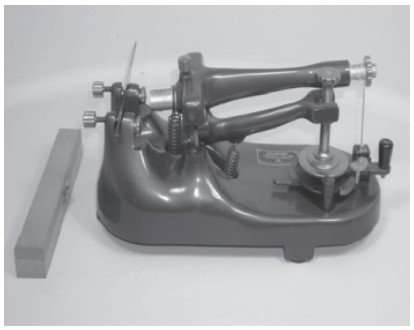
- This instrument is one of the oldest in design, is comparatively inexpensive, and is solely intended for paraffin block sectioning.
- Cambridge swaying microtome is another name for the rocking microtome. The term “rocking” is used because of the arm-like rocking action of the microtome.
- In this form of microtome, the blade remains stationary while the tissue block oscillates in an arc-like motion. This is one of the earliest microtome designs.
- The microtome is suitable for serial sectioning and can cut thin sections with ribbons. This microtome has slightly curved sections.
- The microtome is easy to use and derives its name from the swaying motion of the crossarm.
- This microtome has three moving components, is extremely dependable, and requires minimal upkeep.
- As the tissue advances towards the knife (the slightly biconcave Heiffor knife), which is held rigidly, sections are cut in a curved plane. However, the frame’s fragility makes it susceptible to movement during cutting, and it is difficult to obtain extremely thin sections.
- The swaying microtome has been largely supplanted by the more precise rotary microtome, but it is making a comeback in portable cryostats.
Advantages
- Thin section
- Easy to operate
- Low-cost instrument and reliable
Disadvantages
- Since the tissue is curved, the microtome cannot produce uniform sections.
- Due to the light weight of the microtome, vibrations may occur.
2. Rotary Microtome
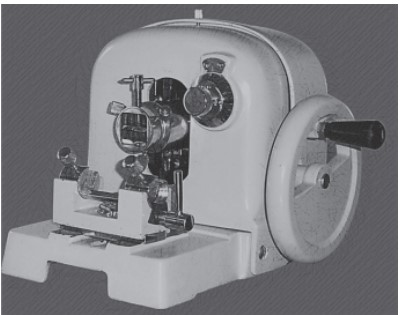
This is the microtome used most frequently in routine laboratory settings. The cutting blade is maintained in a horizontal position, and the tissue block is moved up and down by a rotatory handle affixed to the microtome. With each 360° turn of the wheel’s handle, the block moves down, then up, and the tissue is divided into thin ribbons. This microtome can be semiautomated or automated with respect to the modification and control of the block’s movement and the knife’s angle.
- The name of this microtome is derived from the rotary action of the handwheel that controls the cutting movements. These machines are general-purpose microtomes designed to cut semi-thin to narrow sections for light microscopy.
- The operation is based on the rotational action of a hand wheel that activates the movement of a block towards a knife held rigidly in place. In relation to the knife, the block moves up and down in a vertical plane, slicing flat portions.
- It is optimal for cutting serial sections due to the fact that it is heavier and therefore more stable than the rocking type. This machine can cut larger tissue blocks, and the knife’s cutting angle (knife inclination) is adjustable.
- Since a heavier and larger blade is utilized with this form of microtome, the likelihood of vibration during cutting is reduced.
- On the majority of machines, section thickness specifications range from 0.5μm to 60μm. Tissues imbedded in paraffin wax are typically sectioned within the range of 3 to 5 μm, whereas resin sections range from 0.5 to 1 μm.
Advantages
- It is possible to create 2–3 μm-thin sections of high quality.
- The heaviest and most stable automated rotary microtome minimizes health risks and produces the highest quality sections.
- Excellent tissue ribbon manufacturing.
- Diverse varieties of easily cuttable tissue: firm, fragile, small biopsies, etc.
Disadvantages
- Expensive.
- Unsuitable to cut large block.
- Knife faces up and so may be dangerous to the technical staff.
3. Sledge microtome
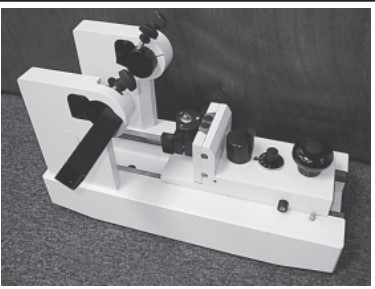
In sledge microtome, the block is fixed within a steel carriage in a static position. The knife glides back and forth across the block’s surface. This microtome is ideal for working with large tissue samples or dense tissue. Typically, base sledge microtome tissue sections are thick (greater than 10 μm).
- This microtome was originally intended for sectioning extremely large tissue masses (e.g., the entire brain). Since World War II, the sledge microtome has become a popular machine for routine use.
- The block-holder is positioned on a steel carriage that slides back and forth on rails against a horizontally fixed knife.
- This microtome is substantial and, as a result, extremely stable and not subject to vibration. Utilizing a large knife (24 cm in length) with a wedge-shaped blade reduces the likelihood of vibration and requires less refining.
- The knife-holding attachments are adjustable and permit easy adjustment of the knife’s tilt and angle (slant) relative to the block. Its action is significantly slower than that of an oscillating or rotary microtome, which is its most significant disadvantage.
Advantages
- Hardened tissue can be sliced.
- It’s easy to remove a sizable chunk of tissue.
- The third-best microtome for big neuropathology sections and ophthalmology.
Disadvantages
- Difficult to get thin section.
- Large slides are required.
4. Sliding Microtome
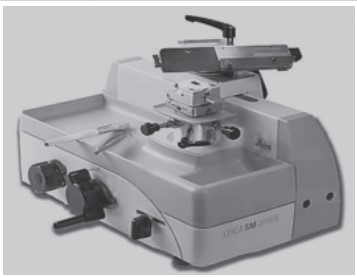
In this microtome the knife is static, and the block moves horizontally over the knife.
- When using a sliding microtome, the blade slides horizontally along an inclined plane against a stationary block.
- Although the sliding microtome was originally developed for cutting celloidine-embedded sections, it can also be used to cut sections embedded in paraffin wax.
Advantages:
- Large sections can be cut.
- Mainly used for celloidin-embedded tissue.
- Simpler design and easy maintenance.
- Brain sections can be cut better by this type of microtome.
Disadvantages:
- The knife may glide in case of hard tissue and may jump.
- Long knives are difficult to sharpen
5. Freezing Microtome/Cryomicrotome

Frozen tissue samples can be sliced using this microtome. The sample is hardened in a chamber of liquid nitrogen before being microtomized there.
- Although other microtomes can be adapted for cutting frozen sections, this type of microtome has traditionally been considered the most effective and widely utilized.
- A cylinder of carbon dioxide (CO2) is connected to the machine via a flexible metal tube that is reinforced in key areas. When using a freezing microtome, the knife is moved while the tissue block is held still, making the cutting process distinct from those described above.
- After each cut, the block advances a specified number of microns. However, it is extremely challenging to create thin sections of consistent, excellent quality with this type of microtome.
- Tissue freezing with this apparatus is possible without using cryogenics like solid carbon dioxide or liquid nitrogen. Prior to the widespread adoption of the cryostat for frozen sectioning, this technique had already gained considerable traction.
- This device employs the principle of the unequal heating of one metal by an electric current passing directly through it and the cooling of the other. The number 12 represents the ‘Peltier’ effect, which describes this phenomenon.
Advantages
- Getting an emergency C-section to make a quick diagnosis.
- Examining nerve biopsies as a research topic.
- Specifically, enzyme histochemistry.
Disadvantages
- It requires constant monitoring to keep the desired temperature.
- Frozen artifacts are common.
- Extremely pricey music gear.
- It is quite challenging to cut through rigid tissue.
6. Vibrating Microtome
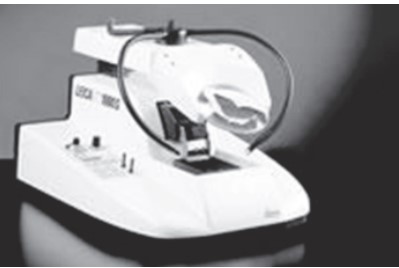
- The vibrating microtome was developed as a means of cutting high-quality sections of live, unfixed plant and animal tissue, with the intention of eventually replacing the hand microtome.
- The fields of enzyme histochemistry and ultrastructural histochemistry benefit most from this instrument’s ability to cut fresh, unprocessed tissue.
- The name of this tool comes from the high-frequency vibrations generated by a safety razor blade, which serve as the instrument’s primary source of energy for cutting.
- The ‘knife’s’ amplitude of vibration can be altered by adjusting the voltage applied to it. Soft materials can be sliced without tearing if they are submerged in a fluid that also helps to dissipate the heat generated by the vibrating razor’s edge.
7. Ultra Microtome
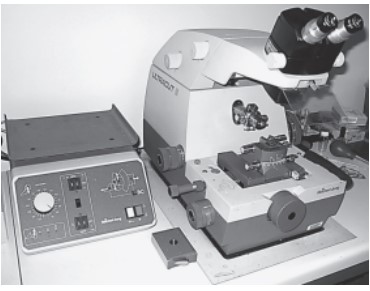
- To get ultra-thin slices for light and electron microscopy, the ultra-microtome is used. It is common practice to embed tiny tissue or industrial product samples in hard resin before reducing them to size. Sections as thin as 10 nm in thickness have reportedly been described.
- This type of microtome features two distinct types of advance mechanisms. Heat induces expansion in a metal strip that is the basis of the thermal mechanism. Whereas in the mechanical type, the advance mechanism is controlled by a microprocessor connected to a precise stepping motor.
- Motorization of the cutting stroke ensures a consistent, repeatable motion that guarantees uniform section thickness. Glass, diamond, or sapphire are the standard materials for making knives.
- Using a microscope, the block is brought to the cutting edge, and when each slice is made, it is floated into a water bath nearby.
8. Saw Microtome
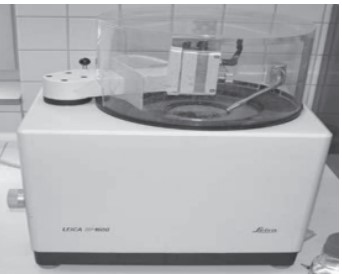
- Saw microtomes are used to remove fragments of calcified bone, glass, or ceramics from other, much harder materials.
- The samples, which are often set in resins, are pushed very slowly against a diamond covered saw spinning at around 600 revolutions per minute.
- Producing portions of 20 μm or more requires a saw blade in pristine condition. Very thin slices cannot be made using a saw microtome.
9. Hand Microtome
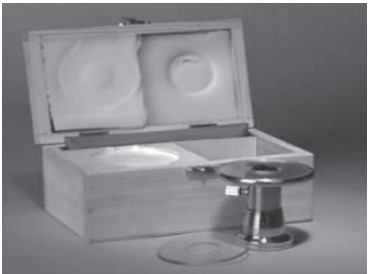
- The hand microtome can only segment naturally stiff plant material, and thin sections of animal tissues are difficult to achieve.
10. Cryostat
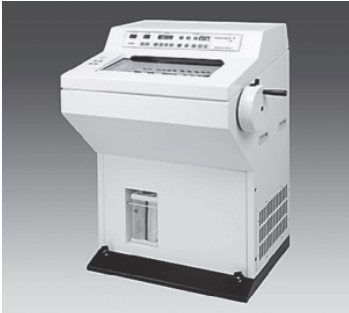
- Thin sections (3-5 μm) of fresh frozen tissue free of ice crystal flaws became necessary after the invention of fluorescent antibody staining procedures by Coons, Creech, and Jones in 1941.
- The tissue needs to be snap frozen at a very low temperature to meet these requirements. First built in 1938, the cryostat was the brainchild of Linderstrom-Lang and Mogensen.
- In 1951, Coons and his colleagues revised the design. Essentially, it’s a deep freeze cabinet with a microtome inside of it (ideally one that won’t corrode).
- A double-paned glass window and a door allow items to be stored and retrieved from the cabinet. The cabinet has a fan and fluorescent lighting to keep things cool.
- The temperature range is from -10 degrees Celsius to -40 degrees Celsius. Fast sectioning can be achieved using any cryostat rather than a freezing microtome.
- For this specific function, certain microtomes have been built with an inside Freon rapid freeze stage. After the tissue is placed on the four block holders and frozen, they are moved to the microtome.
- Staining and mounting may be done quickly because the parts stick so well to the warm slides. Microtome settings allow for slice thicknesses of 2- 16 μm.
B. Automatic microtomes
An automatic microtome is a type of microtome that uses an electric or automated system to control the slicing process. Automatic microtomes are often used in high-volume or industrial settings, where speed and efficiency are critical. Some of the key features and benefits of automatic microtomes include:
- Speed: Automatic microtomes can slice thin sections much more quickly than manual microtomes, making them ideal for use in high-volume settings.
- Precision: Automatic microtomes use advanced technology to ensure very precise and uniform slicing, providing high-quality results for a wide range of applications.
- Efficiency: Automatic microtomes require less manual effort than manual microtomes, reducing the risk of fatigue and repetitive strain injuries in users.
- Consistency: Automatic microtomes can produce consistent results over long periods of time, reducing the risk of errors or inconsistencies in the slicing process.
Some of the key components of an automatic microtome include a sample holder, cutting blade, motor, feed mechanism, and control panel. The sample holder is used to hold the material being sliced in place, while the cutting blade is moved across the material by a motor. The feed mechanism controls the speed and distance that the material is moved in relation to the cutting blade, allowing for very precise control over the slicing process. The control panel allows users to adjust various settings and parameters, such as the slicing speed and thickness.
Overall, automatic microtomes are a powerful tool for high-volume or industrial settings, providing the speed, precision, and efficiency needed to meet the demands of modern research and manufacturing.
Types of Automatic microtomes
- Laser microtome
- Computer microtome
- Ultra-thin computer microtome
1. Laser Microtome
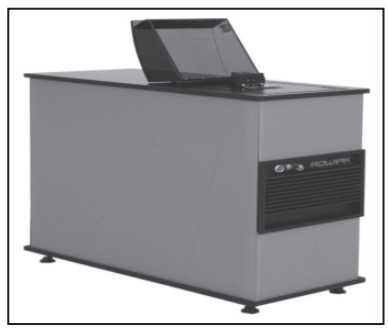
- The laser microtome shown in Figure 11 is a precision tool for cutting through materials without touching them.
- It has cutting-edge femtosecond laser technology built in. It allows for heat-free, non-contact slicing inside of biological tissues and other materials. Slice thicknesses between roughly 5 and 100 μm are possible, depending on the material being treated.
- This laser microtome has numerous benefits, including the ability to cut tissue in its natural form with sub-micrometer precision, less thermal damage, fewer artifacts, and reduced time spent on tissue preparation.
2. Computerized Microtome
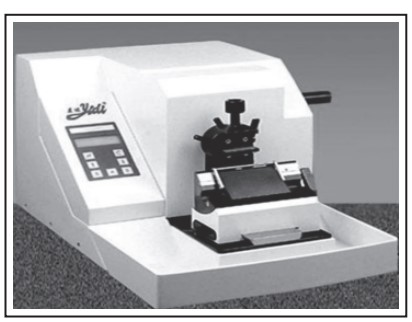
- Cryoscalped and cryoplate technology, as well as a semiconductor freezing switch, are included. The computerized microtome is dual-purpose, performing both conventional paraffin sections and quick freezing sections.
- With a minimum slice adjustment graduation of 1 μm and a maximum slice section of 32 x 32 mm, this microtome can achieve slice thicknesses of 1- 25 μm.
- The temperature of cryo scalpel and cryoplate range between 0ºC ~ -18ºC and -10ºC ~ -40ºC respectively.
Microtome Knife
- The microtome knife plays a crucial role in creating high-quality sections. The initial attempt at creating a suitable cutting surface was a razor blade that had been sharpened; however, these quickly got dull.
- Latta and Hartmann found that newly cut glass might provide edges fine enough for use. A clean, precise blade is the foundation of any successful microtomy.
- Though disposable blades have simplified the process of making high-quality thin sections, they are often inadequate for cutting through tougher tissues like bone.
- Maintaining a razor-sharp knife is still essential, as these tissues present the greatest difficulty for the microtomist. Both the material and the geometry of the knife edge can be used to categorize microtome knives.
Types of Microtome Knife
Based on material of the knife:
– Steel knives
– Non-corrosive knives for cryostat
– Disposable blades
– Tungsten carbide knives
– Glass knives
– Diamond knives
– Sapphire knives
Based on shape of the knife edge (Profile):
– Profile A: Strongly plano-concave/biconcave
– Profile B: Plano-concave
– Profile C: Wedge Shaped
– Profile D: Plane Shaped
Types of Microtome Knife Based on material of the knife
1. Steel Knives
- High-quality carbon or tool-grade steel is used in the production of steel microtome knives, and the blades are heat treated to strengthen the edge.
- The steel must be devoid of contaminants and corrosion inhibitors, and it must also resist rust. Completely hardened blades are the best kind.
- When the hardened area is removed during sharpening, those with merely a surface hardening lose their cutting edge rapidly.
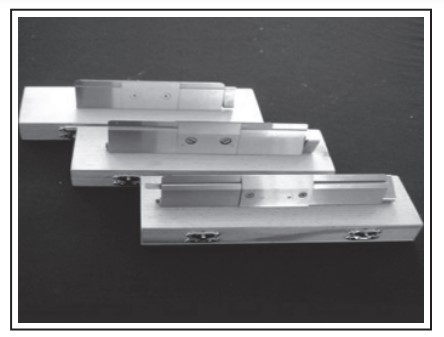
2. Non-Corrosive Knives For Cryostats
- Made from pure, heat-treated stainless steel, these are extremely durable. Chrome levels range from 12 to 15 per cent.
3. Disposable Blades

- You might think of these as improved, beefed-up razor blades. When placed in a specialized holder, these blades reliably cut clean pieces every time.
- In many cases, these have completely supplanted traditional microtome knives. Stainless steel is used in the production of all disposable blades.
- Platinum or chromium coatings can be applied to the cutting edge of disposable blades to make them stronger and last longer. Because of their low cutting resistance and low friction, Teflon-coated blades are ideal for use in cryostats.
- The disposable blade is thinner and smaller than a standard knife, so it heats up faster in the cryostat chamber, saving time that would otherwise be spent changing blades or adjusting the temperature.
- To avoid blade vibration during the cutting stroke, disposable blades require a solid holder.
Today, many laboratories use disposable blades to save time on sharpening. There are two varieties of disposable blades:
- Low-profile blade: These blades are utilised for cutting tiny biopsies or soft, large tissue.
- High-profile blade: These blades are utilised to cut firm to relatively rigid tissue, such as the uterus, the heart, etc.
Advantages
- Simple to replace in seconds.
- No need for sharpening.
- There is no need for a knife sharpener or abrasive powder, so the overall cost of the disposable blade system is reduced.
Disadvantages
- They are not as rigid as an ordinary knife, so vibration effects may be observed.
4. Tungsten Carbide
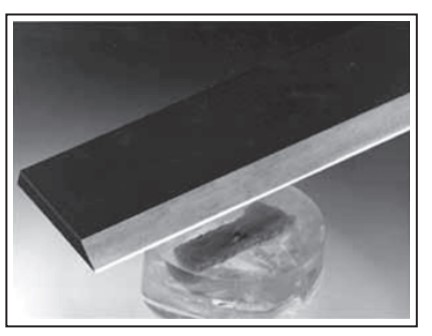
- Knives made from high-quality tungsten carbide are virtually nonmagnetic and 100 times harder than tool steel.
- Due to their extreme hardness, the knives have exceptional wear resistance but are brittle and should be handled with care.
- Per honing, however, up to 30,000 serial sections of undecalcified bone embedded in methacrylate have been reported.
5. Glass Knives
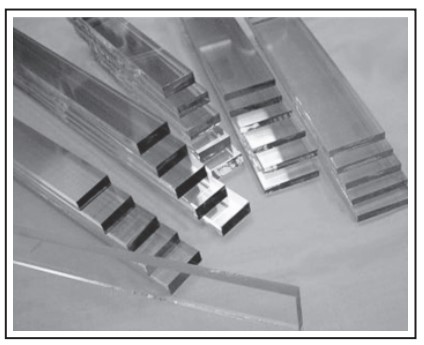
- The cutting edge of glass knives (‘Ralph knives’ with margins of 25 or 38 mm) used for conventional sectioning is parallel to one surface of the glass, whereas the cutting edge of knives used for ultramicrotomy is against / across the thickness of the glass.
- Rapidly produced different profiles of the ‘Ralph knife’ for cutting sections from various embedding media. It is possible to use ‘Ralph blades’ with a rotary microtome due to the availability of glass knife holders.
- Glass blades are hard but fragile and must be handled with care. Changes in the ‘flow’ or’strain’ of the glass after fracture and oxidation impurities lingering in the hardened glass after manufacture cause these knives to deteriorate over time. Therefore, knives should be prepared promptly prior to use.
According to the profile of the cutting edge, Ralph blades can be categorized.
- High profile: 1 to 1.5 centimeters of cutting edge – Appropriate for sectioning delicate embedding media, such as waxes.
- Medium profile: 0.5 to 1 cm cutting edge height – Suitable for sectioning both flexible and hard plastics.
- Low profile: cutting edge height of less than 0.5 cm – Suitable for cutting plastics with a high hardness.
- Front profile: The sloping edge defect renders the knife unusable; this is the result of improperly securing the glass strip at each end.
6. Diamond Knives
- Diamond blades are crafted from flawless gem-quality diamonds. Due to its extreme hardness, diamond blades are extremely durable despite their high cost.
- These blades are predominantly utilised for cutting extremely thin sections.
7. Sapphire Knives
- These blades are made from a single piece of solid sapphire produced artificially from a monocrystal of alumina under computer-controlled thermal conditions.
- Sapphire is sturdier than tungsten carbide or glass, ensuring that the cutting edge of any material will be exceptionally durable.
- The only limitation when using a sapphire knife is the size of the block, as the edge is limited to 11 mm. This type of weapon requires a special knife holder.
Types of Microtome Knife Based on shape of the knife edge (Profile)
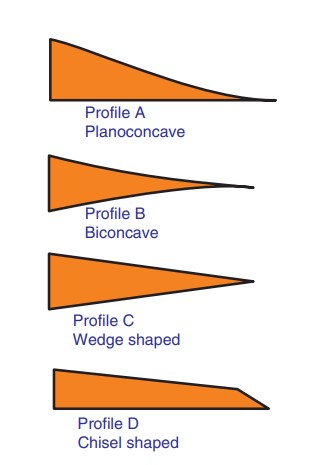
1. PROFILE – A: Strongly plano concave/biconcave
- The plano concave knife has one straight surface and one recessed ground surface. The biconcave blade of the knife features two hollow-ground surfaces.
- Both blades are exceptionally sharp and are used to cut soft, celloidin-imbedded materials and foam compounds.
- These blades are unsuitable for relatively hard materials, which cause the edge to vibrate and result in the chattering phenomenon. When cutting sections, the knife should always be at an angle to the object for optimal results.
2. PROFILE – B: Plano concave
- This knife resembles a profile-A knife, but its rear is thicker. It is used to cut portions from materials that are too difficult to cut with a profile-knife, but it can also be used for paraffin-encased softer materials.
- This knife should be held at an angle to the material being cut. There are plano-concave knives with differing degrees of concavity.
3. PROFILE – C: Wedge Shaped
- The knife with a wedge shape is more rigid than blades with profile A or B and can therefore be used to cut harder materials.
- Due to the extra-thick nature of the tip wedge, this form of knife cannot be ground as sharply as knives with profile A or B.
- It is typically used for cutting sections from embedded paraffin wax, frozen sections, cryostat sections, and small embedded synthetic resin material. This design of knife has a cutting plane that is perpendicular to the object.
4. PROFILE – D: Plane Shaped/Tool edge shaped
- This knife has greater stability than any of the other profile blades, allowing it to cut tough and hard materials. Due to the fact that this knife has only one chamfer, it has the dullest cutting edge of all the knife profiles.
- It is typically employed for slicing synthetic resin blocks, rigid materials embedded in paraffin wax, and large wax blocks.
- The cutting edge of all steel knives is generated by grinding a bevel on each side of the blade for profiles A, B, and C, or onto the angled surface of a knife with profile D. The bevel faces contain a sharper angle than the knife’s primary surfaces.
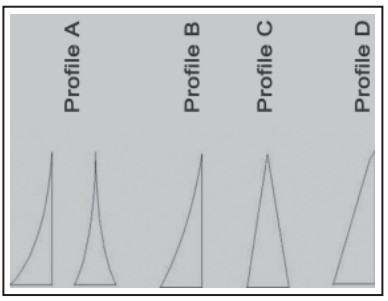
Angles of Knife
The various angles formed by the knife include
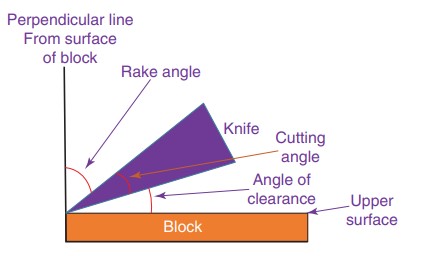
- Rake angle: It is the angle between the upper chamfer of the knife and the line drawn perpendicularly from the surface of the block. Increasing the slope angle facilitates section cutting.
- Angle of clearance: The angle between the knife’s lower bevel and the surface of the block. Typically, it is around 5°. The clearance angle is related to the friction between the knife and block. The smaller the clearance angle, the less compression there will be on the block.
- Bevel angle: This represents the angle between the two planes of a knife.
- Cutting edge: The cutting edge is the straight line formed by the intersection of the bevel’s two planes.
Steps of Tissue Sectioning
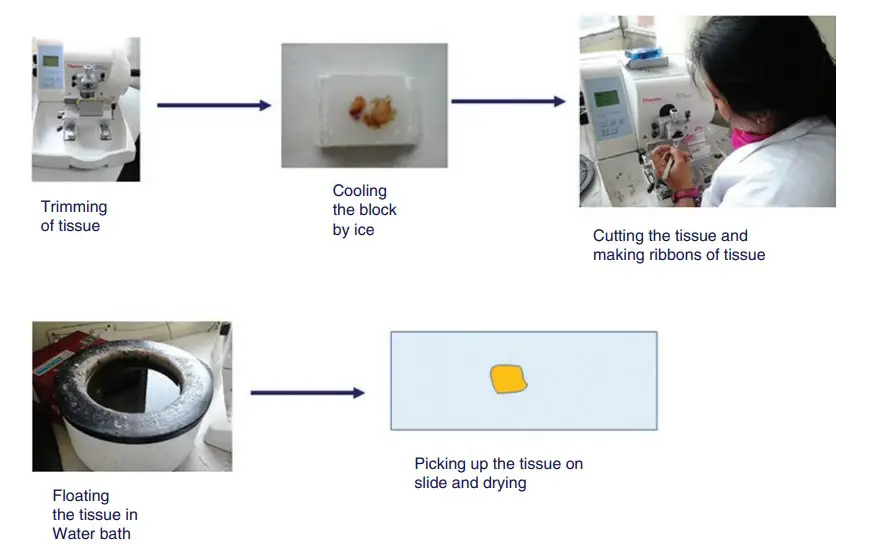
- Trimming the tissue: Tissue trimming is required to expose the tissue component within the paraffin wax for subsequent cutting. The block is secured in the microtome’s chuck, and the paraffin is removed until the tissue is entirely exposed. It is important not to overcut tissue, as this may result in various artefactual changes.
- Cooling the block: Following the initial pruning, the blocks are set aside for 15–20 minutes to cool. This will assist the paraffin and tissue maintain the same consistency. This facilitates trimming.
- Cutting proper: The object is secured in the chuck of the microtome prior to cutting. The block’s cutting surface should be horizontal to the knife. To have a decent section, the clearance angle should be between 2 and 5 degrees. The tissue in the block is cut with a smooth, slow, and delicate stroke. Producing the tissue sections in the form of ribbons. The end of the ribbon is removed from the knife edge using a brush while the point of the ribbon is held by forceps. In the event that the flat section is difficult to obtain, the cutting surface should be gradually warmed with warm water.
- Floating the ribbon: The ribbon of the tissue is suspended in the water bath, which flattens the tissue and eliminates any wrinkles. Using the forceps, the individual components are separated from one another. As previously stated, the temperature of the water immersion must be maintained consistently below the paraffin wax’s melting point. If the temperature of the bath fluctuates, air pockets may form, which can cause tissue rupture.
- Picking up the tissue: The slide is positioned vertically within the water bath in front of the tissue and is withdrawn vertically from the water when the tissue is touched. The tissue collection procedure must be mild and seamless. To prevent confusion, the water bath must be cleaned promptly after each block is cut.
- Drying the section: The slide containing the section being dried is placed in the slide rack. The transparencies are now being dried in a hot oven. The oven temperature should be marginally higher than the paraffin’s melting point.
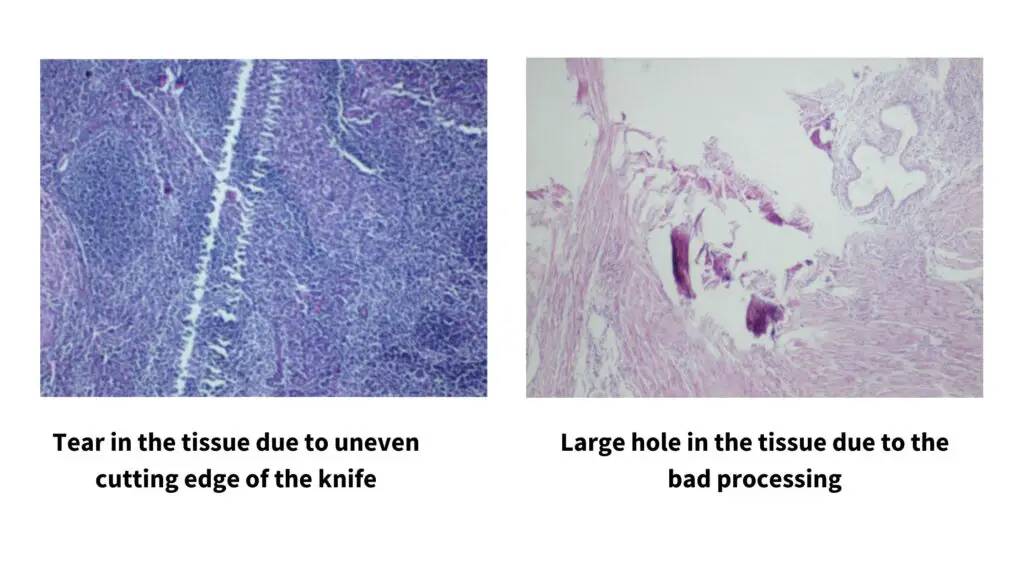
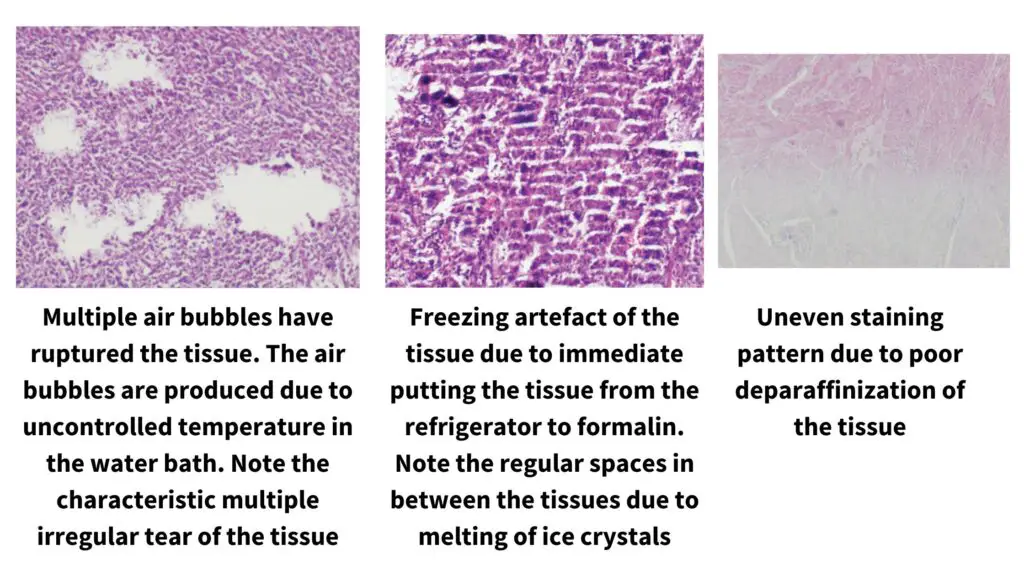
Applications of Microtome
Some of the common uses of microtomes include:
- Histology: Microtomes are used extensively in histology to prepare tissue sections for examination under a microscope. The tissue sections are stained and analyzed to diagnose diseases or investigate cellular structures and functions.
- Pathology: Microtomes are also used in pathology to prepare tissue samples for examination to diagnose diseases such as cancer or infections. The tissue sections obtained using a microtome help pathologists to identify abnormal cellular growth patterns, inflammation, and other changes.
- Neuroscience: In neuroscience, microtomes are used to prepare thin sections of brain and spinal cord tissue samples for detailed examination of the cellular and molecular structure of the nervous system. This helps researchers to understand the mechanisms of various neurological disorders.
- Botany: Microtomes are used in botany to prepare thin sections of plant tissues for analysis of the structure and function of different parts of the plant, such as leaves, stems, and roots.
- Material science: Microtomes are also used in material science to prepare thin sections of materials, such as metals, ceramics, and polymers, for analysis under a microscope.
Advantages of Microtome
Microtomes have several advantages that make them a valuable tool for preparing thin tissue sections for microscopic examination. Some of these advantages include:
- Precision: Microtomes allow for precise and consistent sectioning of tissue samples, ensuring that the thickness of each section is uniform and reproducible. This is critical for accurate diagnosis and research.
- Versatility: Microtomes can be used to prepare tissue samples from a wide range of sources, including human and animal tissues, plant tissues, and materials. This makes them a versatile tool for use in many fields of research.
- Efficiency: Microtomes are designed for rapid and efficient sectioning of tissue samples, allowing researchers and pathologists to process large numbers of samples in a relatively short amount of time.
- High-quality sections: Microtomes produce thin tissue sections with high clarity and minimal distortion, which is essential for accurate interpretation of tissue structure and morphology.
- Flexibility: Microtomes can be adjusted to produce tissue sections of varying thicknesses, allowing researchers and pathologists to tailor the sectioning process to their specific needs.
Disadvantages of Microtome
While microtomes have many advantages, they also have some disadvantages that are important to consider. Some of these disadvantages include:
- Skill level required: The process of using a microtome to produce high-quality tissue sections requires a high level of skill and training. Novice users may find it difficult to obtain consistent and accurate results.
- Cost: Microtomes can be expensive to purchase and maintain, particularly for high-end models that offer advanced features and capabilities.
- Time-consuming: Although microtomes are designed for efficient sectioning of tissue samples, the process of preparing and processing samples can be time-consuming and may require additional steps such as staining and mounting.
- Risk of sample damage: Improper use of a microtome can result in damage to tissue samples, particularly if the blade is dull or improperly aligned. This can result in distorted or unusable tissue sections.
- Limited section thickness: While microtomes can produce thin tissue sections with high clarity and minimal distortion, the maximum section thickness is limited. This may be a disadvantage in some cases where thicker sections are required.
FAQ
What is a microtome?
A microtome is a specialized instrument used in histology and pathology to slice very thin sections of tissue samples for microscopic examination.
What types of microtomes are available?
There are several types of microtomes available, including rotary microtomes, sliding microtomes, and vibratomes.
What is the difference between a rotary microtome and a sliding microtome?
A rotary microtome uses a rotating knife to slice tissue samples, while a sliding microtome uses a stationary knife and a moving platform to slice the tissue.
What is a vibratome?
A vibratome is a specialized type of microtome that uses a vibrating blade to produce thin tissue sections without freezing or embedding the tissue.
What are the applications of microtomes?
Microtomes are used in a wide range of applications, including histology, pathology, neuroscience, botany, and material science.
How do you prepare tissue samples for microtome sectioning?
Tissue samples must be fixed, dehydrated, embedded, and trimmed before they can be sectioned using a microtome.
How thick are the tissue sections produced by a microtome?
The thickness of the tissue sections produced by a microtome can vary depending on the instrument and the user’s settings, but typically range from 1 to 20 microns.
How do you maintain a microtome?
Microtomes should be cleaned and lubricated regularly, and the blade should be sharpened or replaced as needed.
Can microtomes be used to section live tissue?
No, microtomes are only used to section fixed and embedded tissue samples.
Are there any safety concerns associated with using a microtome?
Yes, microtomes can be dangerous if not used properly, as the sharp blade can cause injury. Users should wear protective equipment, such as gloves and eye protection, and follow proper safety protocols.
References
- Mohammed, Faraz & Thapasum Fairozekhan, Arishiya & Mohamed, Shamaz. (2012). Microtomes and Microtome Knives – A Review and Proposed Classification. Annal Dent Univ Malaya. 19. 43-50.
- Dey, P. (2018). Tissue Microtomy: Principle and Procedure. In: Basic and Advanced Laboratory Techniques in Histopathology and Cytology. Springer, Singapore. https://doi.org/10.1007/978-981-10-8252-8_5
- McMillan, D. B., & Harris, R. J. (2018). Introduction. An Atlas of Comparative Vertebrate Histology, ix–xxix. doi:10.1016/b978-0-12-410424-2.00018-4
- https://nios.ac.in/media/documents/dmlt/HC/Lesson-09.pdf
- https://link.springer.com/chapter/10.1007/978-981-10-8252-8_5
- https://www.leicabiosystems.com/en-in/histology-equipment/microtomes/
